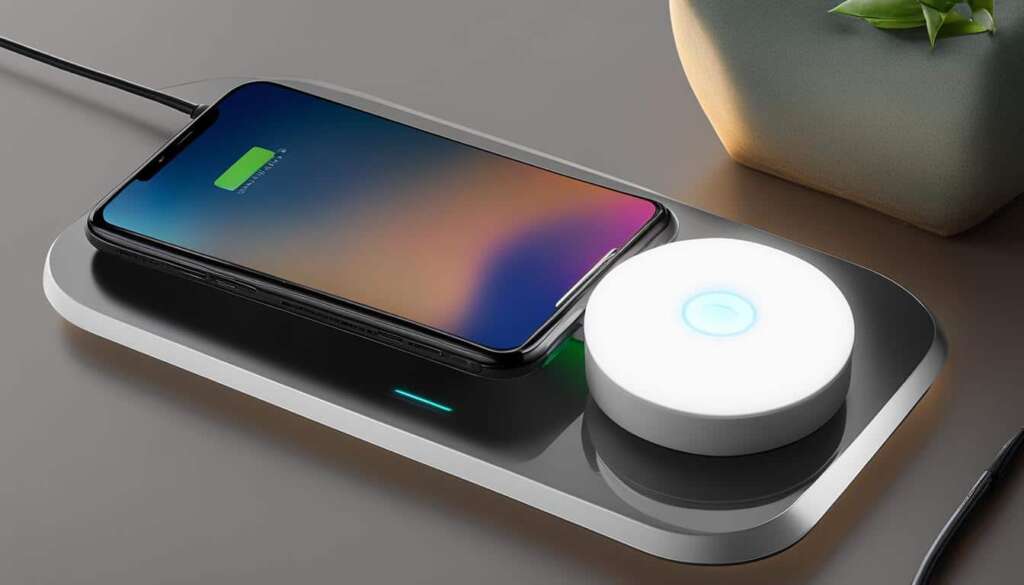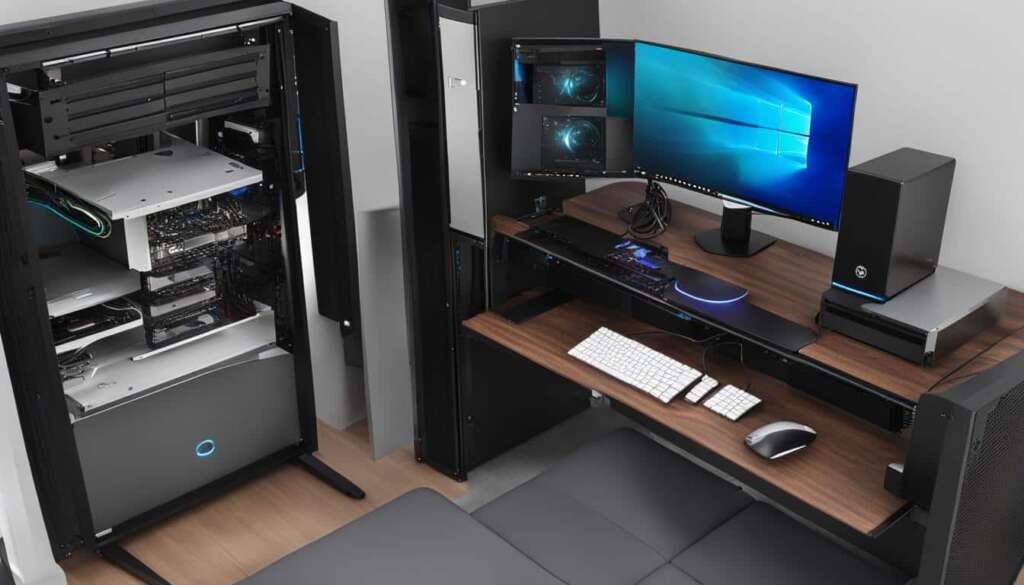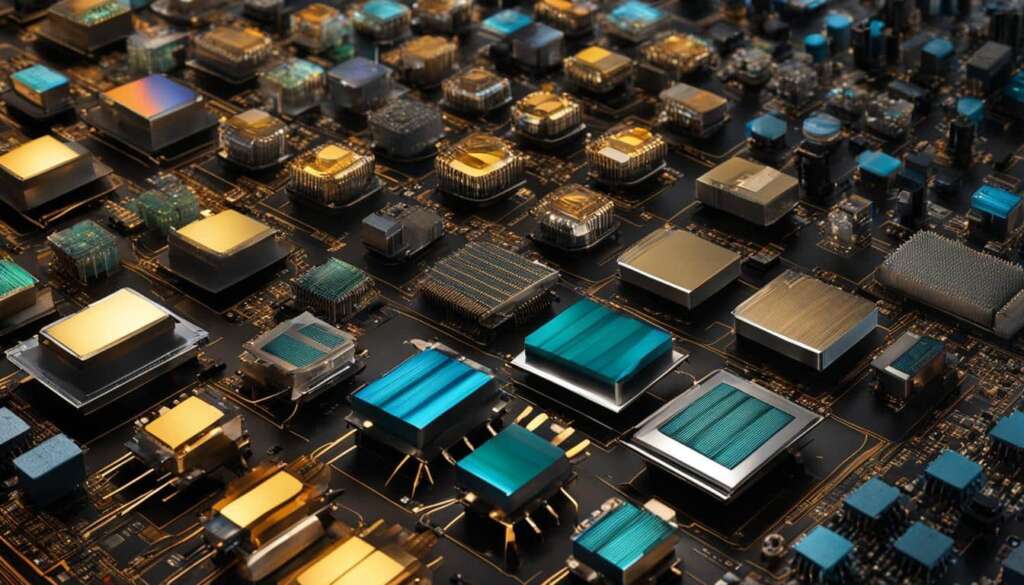Table of Contents
The world of technology is constantly evolving, and one area that has seen significant advancements is wireless charging. With the increasing popularity of mobile devices and the need for convenient and cable-free charging solutions, wireless charging has become a game-changer in the industry. In this article, we will explore the latest developments in wireless charging technologies and how they are shaping the future of power transfer.
Wireless charging, also known as inductive charging, utilizes Qi technology to transfer power to mobile devices without the need for traditional chargers or charging cables. This technology allows users to simply place their devices on a charging pad, and the power is transferred wirelessly.
One of the key advantages of wireless charging is its fast charging capabilities. With advancements in wireless power transfer, users can now enjoy faster charging speeds for their devices, reducing the waiting time and ensuring they are always ready to go. Additionally, wireless charging offers the convenience of cable-free charging, eliminating the hassle of tangled wires and the need for multiple chargers.
The wireless charging market is experiencing rapid growth, with a projected value of $40.24 billion by 2027. This growth is driven by the increasing adoption of wireless charging in various industries, including healthcare, automotive, aerospace, and consumer goods production. The reliability and security of wireless charging technology have made it a preferred choice for powering critical devices and ensuring uninterrupted performance.
As wireless charging continues to evolve, we can expect to see further innovations that will shape the future of power transfer. Advancements such as extended charging range, universal compatibility, and integration into everyday environments are paving the way for a seamless and eco-friendly charging experience. These developments not only enhance convenience for users but also contribute to a more sustainable future.
In conclusion, wireless charging technologies are revolutionizing the way we power our devices. With their fast charging capabilities, cable-free convenience, and widespread adoption, wireless charging is here to stay. Stay tuned as we explore the types, standards, advantages, and emerging trends in wireless charging, uncovering the potential for a future driven by wireless power transfer.
Types and Working of Wireless Charging Technology
Wireless charging technology has revolutionized the way we charge our devices, providing a convenient and cable-free solution. There are three main types of wireless charging technology: radio charging, inductive charging, and resonance charging. Each type has its own working mechanism and is used for different purposes.
Radio Charging
Radio charging is commonly used with small devices such as wireless keyboards and hearing aids. It uses radio waves to transfer power from the charging pad to the device. The charging pad emits radio waves, which are received by a small receiver in the device, converting them into electrical energy. This type of wireless charging is ideal for low-power devices and is often used in situations where mobility is crucial.
Inductive Charging
Inductive charging, also known as Qi technology, is the most widely used wireless charging technology for smartphones and wearables. It works by creating a magnetic field between the charging pad and the device. The charging pad contains a coil that generates an alternating current, which creates a magnetic field. The device has a coil receiver that captures the magnetic field and converts it into electrical energy, charging the battery. Inductive charging is convenient and popular due to its compatibility with various mobile devices.
Resonance Charging
Resonance charging is used for larger devices like laptops and electric vehicles. It works by using electromagnetic resonance between the charging pad and the device. The charging pad and the device both have coils that resonate at the same frequency. When the coils are in range, the energy is transferred wirelessly through the magnetic field created by the resonance. This type of wireless charging allows for greater charging distances and is often used in applications where high power transfer is required.
These three types of wireless charging technology provide efficient and cable-free charging solutions for various devices. Whether it’s small accessories, smartphones, or larger devices, wireless charging is revolutionizing the way we power our devices, making our lives more convenient and clutter-free.
Table: Comparison of Wireless Charging Technologies
| Wireless Charging Technology | Commonly Used For | Main Advantages |
|---|---|---|
| Radio Charging | Small devices like wireless keyboards and hearing aids | – Mobility – Low-power charging |
| Inductive Charging (Qi Technology) | Smartphones and wearables | – Convenience – Compatibility with mobile devices |
| Resonance Charging | Laptops and electric vehicles | – Greater charging distances – High power transfer |
What are Wireless Charging Standards and Their Types
Wireless charging standards play a crucial role in ensuring compatibility and standardization in the industry. These standards define the specifications and protocols for wireless charging devices, allowing seamless charging between different brands and models. The three main wireless charging standards are the Qi standard, the Ki cordless kitchen standard, and the SAE standard.
The Qi standard is the most widely adopted wireless charging standard. Developed by the Wireless Power Consortium (WPC), it is utilized for a wide range of devices including smartphones, tablets, and smartwatches. Qi standard chargers use inductive charging, allowing for cable-free charging by simply placing the device on a compatible charging pad or surface.
The Ki cordless kitchen standard focuses on wireless charging solutions for kitchen appliances. It enables the charging of devices like electric kettles, blenders, and coffee machines. The Ki standard ensures the safety and efficiency of wireless charging in a kitchen environment, where water and other liquids are present.
The SAE standard is specifically designed for electric vehicles (EVs). It defines the guidelines for wireless charging systems used in EVs, eliminating the need for physical charging cables. The SAE standard ensures efficient and reliable charging for electric vehicles, making EV charging more convenient and user-friendly.
| Wireless Charging Standard | Developed By | Applications |
|---|---|---|
| Qi standard | Wireless Power Consortium (WPC) | Smartphones, tablets, smartwatches, etc. |
| Ki cordless kitchen standard | Wireless Power Consortium (WPC) | Kitchen appliances |
| SAE standard | Society of Automotive Engineers (SAE) | Electric vehicles (EVs) |
These wireless charging standards are constantly evolving, with ongoing research and development to improve efficiency, compatibility, and integration. The adoption of these standards ensures a consistent and user-friendly charging experience across different devices and industries.
Advantages of Wireless Charging Technology
Wireless charging technology offers numerous advantages that are driving its growing popularity in various industries. One of the key benefits is convenience. With wireless charging, users no longer need to fumble with cables or search for the right charger. Instead, they can simply place their devices on a charging pad or dock, and the charging process begins automatically. This eliminates the hassle of plugging and unplugging cables, making it a hassle-free and time-saving solution.
Reliability is another advantage of wireless charging. Traditional charging methods often involve wear and tear on charging ports, resulting in poor connections and intermittent charging. With wireless charging, there are no physical connectors involved, reducing the risk of port damage and ensuring a more reliable charging experience. This is particularly beneficial for devices that are frequently charged and can help extend their lifespan.
Security is a critical consideration when it comes to charging devices. Wired chargers can be vulnerable to electrical faults and potential safety hazards. Wireless charging technology eliminates these risks by utilizing a closed system that operates within specific safety parameters. This ensures secure and efficient charging without the risk of electrical failures, short circuits, or overheating.
Cable-free charging also offers enhanced aesthetics, providing a cleaner and clutter-free charging experience. There is no need for multiple cables and chargers cluttering up desk space or tangled wires. With wireless charging pads or docks, users can create a streamlined and organized charging station. This not only improves the overall look and feel of the workspace but also promotes a more efficient and productive environment.
Overall, wireless charging technology offers convenience, reliability, security, and enhanced aesthetics. As it continues to evolve, it is expected to play a significant role in various industries, providing a seamless and efficient charging solution for a wide range of devices.
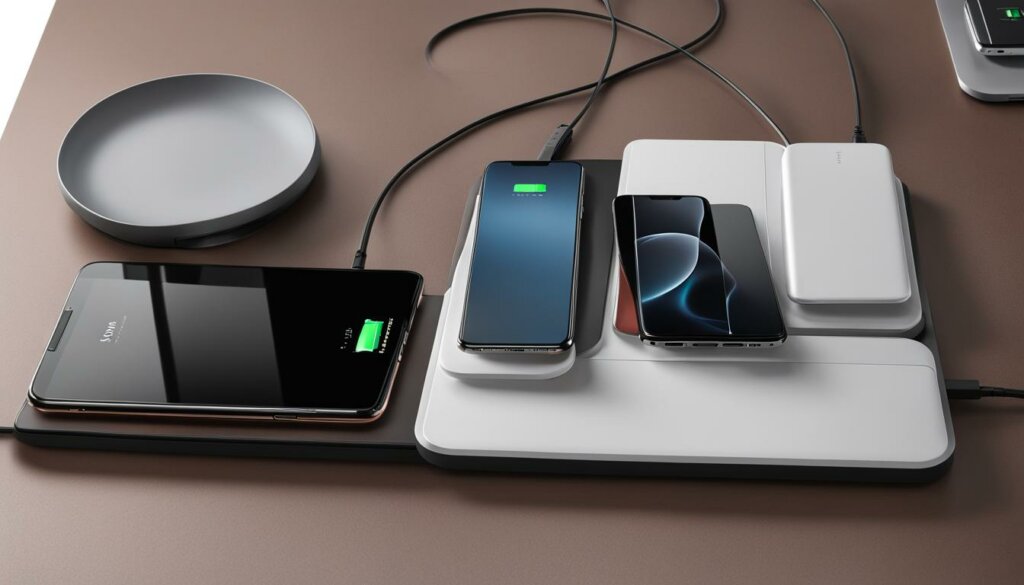
The Evolution of Wireless Charging: Innovations Shaping the Future
Wireless charging technology has undergone significant evolution in recent years, with various innovations that are shaping the future of this technology. These advancements include faster charging speeds, extended charging range, universal compatibility, integration into everyday environments, and the development of eco-friendly solutions.
One of the key advancements in wireless charging technology is the introduction of fast charging capabilities. This allows devices to be charged at a much more rapid pace, significantly reducing the time required for charging. For instance, some wireless chargers now offer the ability to charge a smartphone from 0% to 50% in just 30 minutes, providing users with greater convenience and flexibility.
Another notable innovation in wireless charging is the extended charging range. This means that devices can be charged wirelessly even when they are not in close proximity to the charging pad. This technology enables a more flexible charging experience and opens up possibilities for wireless charging in various environments, such as public spaces, workplaces, and even vehicles.
“The future of wireless charging lies in its ability to offer universal compatibility”
Universal compatibility is also a crucial aspect of the future of wireless charging. The goal is to create a standard that allows devices from different manufacturers to be charged using a single charging pad. This eliminates the need for multiple charging cables and adapters, providing a seamless and user-friendly charging experience. The Qi standard, for example, is widely adopted and supported by a range of mobile devices, making it easier for consumers to use wireless charging without compatibility issues.
Eco-friendly solutions are also a significant focus in the evolution of wireless charging. With increasing concerns about environmental sustainability, manufacturers are developing wireless charging technologies that are more energy-efficient and reduce overall carbon footprint. These eco-friendly solutions aim to provide sustainable power transfer options that align with global efforts to reduce greenhouse gas emissions and combat climate change.
| Advancements | Key Features |
|---|---|
| Faster Charging Speeds | Reduce charging time for devices |
| Extended Charging Range | Charge devices wirelessly at a distance |
| Universal Compatibility | Charge devices from different manufacturers |
| Eco-friendly Solutions | Reduce energy consumption and carbon footprint |
Emerging Trends in Wireless Charging: Shaping the Future of Power
The future of wireless charging is filled with exciting trends that are shaping the way we power our devices. These emerging trends are not only enhancing the charging experience but also paving the way for a more integrated and sustainable future.
One of the key trends in wireless charging is the rapid advancement in fast charging technology. With this innovation, users can enjoy quicker and more efficient charging for their devices, eliminating the need for long waiting times. This trend is particularly beneficial for users who rely heavily on their smartphones and other mobile devices throughout the day.
Another trend that is gaining momentum is extended range wireless charging. This technology allows users to charge their devices from a greater distance, eliminating the need for physical contact with charging pads. This is especially useful in environments where convenience and flexibility are crucial, such as public spaces, offices, and even vehicles.
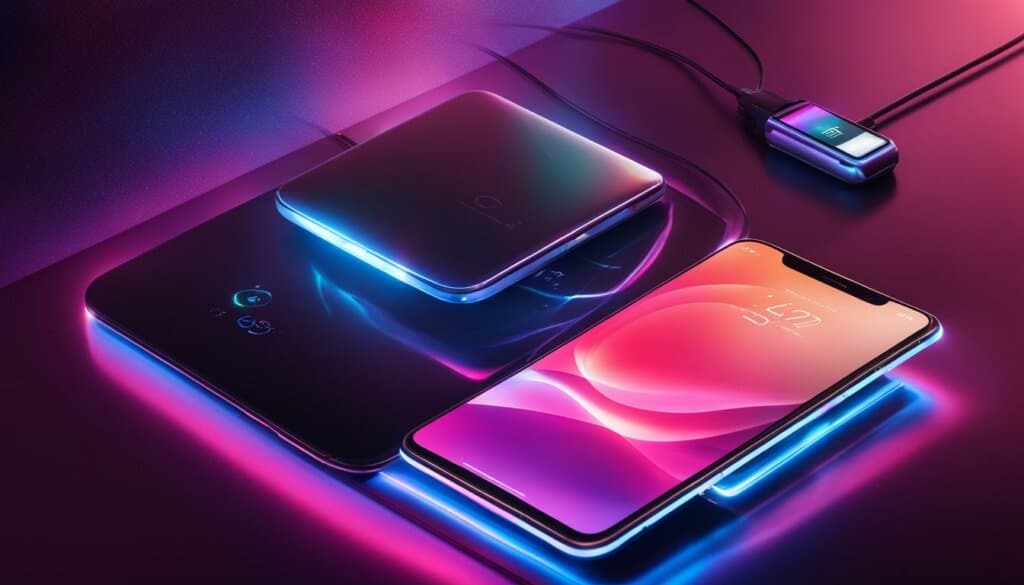
Universal compatibility is also a significant trend in wireless charging. As the number of wireless charging-enabled devices continues to grow, the need for compatibility across different brands and models becomes crucial. Universal compatibility ensures that users can charge their devices seamlessly, regardless of the make or model.
Integration into everyday environments is another trend that is shaping the future of wireless charging. The technology is being integrated into various everyday objects, such as furniture, countertops, and even public transportation. This seamless integration allows for wireless charging capabilities to be readily available wherever users go, providing a truly convenient charging experience.
Key Trends in Wireless Charging:
- Rapid advancements in fast charging technology
- Extended range wireless charging
- Universal compatibility across devices
- Integration into everyday environments
These trends are not only shaping the future of wireless charging but also opening up new possibilities in various industries. From multi-device charging in healthcare settings to automotive integration and powering IoT devices, wireless charging is set to revolutionize the way we power our lives.
Unleashing Wireless Potential: Advancements Paving the Way for Charging Innovation
Advancements in wireless charging technology are driving innovation and revolutionizing the way devices are powered and charged. The introduction of inductive charging, resonant charging, and over-the-air charging has opened up new possibilities for efficient, convenient, and compatible charging experiences.
Inductive charging, also known as wireless charging, uses an electromagnetic field to transfer energy between a charging pad and a compatible device. This method eliminates the need for cumbersome cables and allows for hassle-free charging. Resonant charging, on the other hand, enables devices to charge wirelessly even when not in direct contact with a charging pad. It extends the range of wireless charging and offers the potential for charging devices over longer distances.
One of the most exciting advancements in wireless charging technology is over-the-air charging. This revolutionary concept aims to deliver wireless power transmission over a distance, allowing devices to be charged without the need for any physical connection. Imagine walking into a room and having your smartphone automatically charge without plugging it in or placing it on a charging pad. Over-the-air charging has the potential to transform the way we power our devices and create a truly wireless future.
“The introduction of inductive charging, resonant charging, and over-the-air charging has opened up new possibilities for efficient, convenient, and compatible charging experiences.”
These advancements in wireless charging technology offer greater efficiency, enhanced convenience, and improved compatibility across a wide range of devices. Efficiency is improved through optimized power transfer methods, ensuring minimal energy loss during the charging process. Convenience is enhanced by eliminating the need for cables and allowing devices to be charged effortlessly. Compatibility is improved through the development of wireless charging standards, such as the widely adopted Qi standard, which ensures interoperability between different devices and chargers.
| Advantages of Advancements in Wireless Charging |
|---|
| Improved efficiency |
| Enhanced convenience |
| Greater compatibility |
The advancements in wireless charging technology are paving the way for a future where charging is seamless, convenient, and accessible. With continued research and development, we can expect to see even more innovative solutions that further enhance the wireless charging experience.

The Future of Wireless Charging: Overcoming Challenges
While wireless charging has made significant progress, there are still challenges to overcome. One key challenge is the efficiency of wireless power transfer, as some energy is lost in the form of heat during the charging process. Researchers and engineers are working on improving power transfer efficiency to maximize the benefits of wireless charging.
Another challenge is the widespread adoption of wireless charging infrastructure. To fully realize the potential of wireless charging, charging pads and compatible devices need to be widely available in public spaces, homes, and workplaces. The integration of wireless charging technology into furniture, vehicles, and public infrastructure will play a crucial role in addressing this challenge.
Despite these challenges, the advancements in wireless charging technology continue to progress at a rapid pace. As the demand for cable-free charging solutions grows, so will the investment in research and development, leading to further innovations and improvements in wireless charging technology.
The Benefits of Wireless Charging
Wireless charging offers numerous advantages over traditional wired charging methods. One of the main benefits is convenience. With wireless charging, there’s no need to fumble with tangled cables or search for the right charging port. Simply place your device on a charging pad or dock, and it will start charging automatically. This makes wireless charging particularly convenient for busy individuals or those on the go.
Another advantage of wireless charging is reduced wear and tear on device ports. Constantly plugging and unplugging cables can cause damage to the charging port over time, leading to connection issues or even rendering the port unusable. With wireless charging, there’s no need to worry about wear and tear on your device’s charging port, as it eliminates the need for physical connections.
In addition to convenience and reduced wear and tear, wireless charging also offers enhanced safety. Unlike wired chargers, which can pose electrical risks if not used correctly, wireless chargers are designed with safety in mind. They incorporate features like temperature control and overcharging protection to ensure a safe and reliable charging experience. This gives users peace of mind knowing that their devices are being charged safely, even overnight or when they’re not around.
| Benefits of Wireless Charging | Examples |
|---|---|
| Convenience | Wirelessly charge devices without the need for cables |
| Reduced wear and tear | Avoid damage to charging ports from constant plugging and unplugging |
| Safety | Built-in safety features protect against electrical risks and overcharging |
Lastly, wireless charging offers enhanced aesthetics. With no cables cluttering up your workspace or bedside table, wireless chargers provide a clean and minimalist look. They blend seamlessly into various environments, whether it’s an office, home, or public space. Additionally, wireless charging pads are available in a range of stylish designs, allowing users to choose a charger that complements their personal style or matches their device.
Overall, the benefits of wireless charging make it an attractive option for both personal and professional use. Its convenience, reduced wear and tear, safety features, and enhanced aesthetics make it a compelling choice for anyone looking for a hassle-free and efficient charging solution.
The Future of Charging
As wireless charging technology continues to advance, we can expect to see increased adoption, seamless integration, longer charging distances, and greater compatibility. The convenience of cable-free charging has already made it a popular choice among consumers, and as more devices become compatible with wireless chargers, its adoption is likely to grow further.
One key aspect of the future of wireless charging is its seamless integration into everyday environments. Imagine walking into a coffee shop or airport lounge and finding wireless charging pads built into tables, countertops, and even walls. This level of integration would eliminate the need for carrying around bulky chargers and cables, making it easier than ever to keep our devices powered up.
Another exciting development is the ability to charge devices over longer distances. While current wireless chargers require devices to be placed directly on the charging pad, future advancements may enable charging from several feet away. This would open up new possibilities for charging multiple devices simultaneously without the need for precise alignment.
Lastly, improved compatibility will be a key driver for the future of wireless charging. As more manufacturers adopt wireless charging standards like Qi, we can expect to see greater compatibility across different devices. This means that regardless of the brand or model of your device, you’ll be able to enjoy the convenience of wireless charging.
Table: Comparison of Wireless Charging Technologies
| Technology | Charging Range | Compatibility | Efficiency |
|---|---|---|---|
| Inductive Charging (Qi) | Short range (direct contact) | Widely compatible | High efficiency |
| Resonant Charging | Moderate range (up to a few inches) | Compatible with some devices | Moderate efficiency |
| Radio Charging | Short range (up to a few inches) | Limited compatibility | Low efficiency |
Table: Comparison of Wireless Charging Technologies
While inductive charging, such as Qi technology, is currently the most popular wireless charging method, resonant charging and radio charging offer different advantages in terms of charging range and compatibility. As technology continues to evolve, we can expect to see improvements in the efficiency and range of all wireless charging methods.
Conclusion
Wireless charging has revolutionised the way we power our devices, and its future is promising. With ongoing advancements in technology and research, wireless charging is set to become a crucial method of power transfer. Its convenience, efficiency, and sustainability make it an attractive choice for users and industries alike.
In the coming years, we can expect to see further developments and trends in wireless charging. As more devices and industries embrace this technology, we will witness seamless integration into everyday environments. Longer charging distances and greater compatibility will enhance the user experience, providing even more convenience and flexibility.
The future of charging is wireless, and it holds numerous advantages over traditional wired methods. Not only does wireless charging eliminate the hassle of cables, but it also reduces wear and tear on device ports. Enhanced safety features and improved aesthetics further contribute to its appeal. From smartphones to electric vehicles, wireless charging is suitable for a wide range of devices and industries.
As the wireless charging market continues to grow, it will undoubtedly shape the way we power our devices in the future. Its efficiency, convenience, and sustainability drive its increasing adoption. With ongoing innovations and a focus on ecological solutions, wireless charging is poised to play a vital role in the power ecosystem for years to come.
FAQ
What is wireless charging?
Wireless charging is a method of powering and charging electrical equipment without the need for cables. It uses electromagnetic fields to transfer energy between a charger and a compatible device.
How does wireless charging work?
Wireless charging technology uses electromagnetic fields to transfer energy between a charger (charging pad) and a compatible device (such as a smartphone or wearable). The charger generates an electromagnetic field that induces an electrical current in the device, which is then used to charge the battery.
What are the types of wireless charging technology?
There are three types of wireless charging technology: radio charging, inductive charging, and resonance charging. Radio charging is commonly used with small devices like wireless keyboards and hearing aids, while inductive charging, such as Qi technology, is used for smartphones and wearables. Resonance charging is used for larger devices like laptops and electric vehicles.
What are wireless charging standards?
Wireless charging standards, such as Qi, Ki cordless kitchen standard, and SAE standard, have been developed to ensure compatibility and standardization in the industry. The Qi standard is the most widely used wireless standard, followed by the Ki cordless kitchen standard for kitchen appliances and the SAE standard for electric vehicles.
What are the advantages of wireless charging?
Wireless charging offers several benefits over traditional wired charging methods. It provides convenience by eliminating the need for cables and reducing clutter. It also reduces wear and tear on device ports, improves safety by reducing the risk of electrical and device failures, and enhances aesthetics.
How is wireless charging evolving?
Wireless charging has evolved significantly, with innovations such as faster charging speeds, extended charging range, universal compatibility, integration into everyday environments, and eco-friendly solutions. These advancements are shaping the future of wireless charging and driving its widespread adoption.
What are the emerging trends in wireless charging?
The emerging trends in wireless charging include rapid advancements in fast charging, extended range wireless charging, universal compatibility, integration into everyday environments, eco-friendly solutions, multi-device charging, automotive integration, and its role in healthcare and IoT devices. These trends are shaping the future of wireless charging technology.
What are the benefits of wireless charging?
Wireless charging offers several benefits, including convenience, reduced wear and tear on device ports, improved safety, and enhanced aesthetics. It provides a clutter-free charging experience and is suitable for various devices and industries.
What does the future of wireless charging hold?
The future of wireless charging includes increased adoption, seamless integration into everyday environments, longer charging distances, and greater compatibility. As technology continues to advance, wireless charging is expected to become more widely used and integrated into various aspects of our lives.
How is wireless charging paving the way for charging innovation?
Advancements in wireless charging technology, such as inductive charging, resonant charging, and over-the-air charging, are paving the way for charging innovation. These technologies offer improved efficiency, convenience, compatibility, and the potential for wireless charging over long distances.
What is the role of wireless charging in the future?
Wireless charging is set to revolutionize the way we power our devices. With advancements in technology and ongoing research, the future of wireless charging looks promising. It offers convenience, efficiency, and sustainability, making it a crucial method of power transfer in the future.
Source Links
- https://www.linkedin.com/pulse/future-development-trends-wireless-charging-technology-kira-cheng
- https://utilitiesone.com/the-future-of-wireless-charging-new-standards-and-innovations
- https://www.einfochips.com/blog/wireless-charging-technology-of-the-future-and-its-applications/amp/

